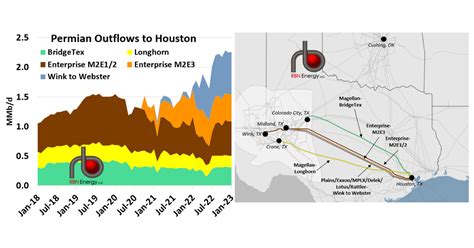Permian to Houston Pipeline: A Step-by-Step Cost Guide
The Permian Basin, a prolific oil and gas region in West Texas and New Mexico, requires robust infrastructure to transport its vast energy resources to major refining and distribution hubs like Houston. This necessitates a complex network of pipelines, and understanding the costs involved in constructing and maintaining these crucial arteries is critical for investors, policymakers, and energy professionals alike. This guide breaks down the cost of building a Permian to Houston pipeline step-by-step, considering various factors influencing the final price tag.
1. Project Planning & Permitting:
This initial phase is often underestimated but is crucial for the overall project success and cost-effectiveness. It involves:
- Feasibility Studies: These detailed assessments analyze the geological conditions, environmental impact, and optimal pipeline route, influencing the overall length and construction challenges. Costs here can range from $500,000 to several million dollars, depending on the complexity and scope of the study.
- Environmental Impact Assessment (EIA): Compliance with environmental regulations is paramount. Conducting thorough EIAs, navigating permitting processes with federal and state agencies (like the EPA and relevant state environmental commissions), and potentially mitigating environmental impacts all contribute significantly to the upfront costs. Expect to allocate $1 million to $5 million or more for this phase, depending on the project's scale and environmental sensitivity.
- Right-of-Way Acquisition: Securing land easements along the pipeline route is a lengthy and often expensive process, involving negotiations with landowners and potentially legal disputes. Costs vary wildly depending on land values and the number of landowners involved but can easily reach millions of dollars.
- Engineering & Design: Detailed engineering designs are essential for accurate cost estimations and efficient construction. This includes specifying pipeline diameter, material, coating, and the design of pump stations and other critical infrastructure. These costs are typically in the range of $1 to $3 million per 100 miles of pipeline.
2. Pipeline Construction:
This phase constitutes the bulk of the project's expenses. Key cost components include:
- Pipeline Material: Steel pipe constitutes the most significant expense. Prices fluctuate based on steel market conditions, pipeline diameter, and wall thickness. Expect to allocate $100,000 to $500,000 per mile, depending on the specifications.
- Welding & Installation: Specialized welders and skilled labor are required for the precise joining of pipe sections. Labor costs depend on the prevailing wage rates and the project's geographical location. Expect $50,000 to $200,000 per mile for this crucial stage.
- Coating & Protection: Applying protective coatings to prevent corrosion and ensure pipeline longevity is essential. This adds to the overall costs, with prices ranging from $10,000 to $50,000 per mile.
- Pump Stations & Compressor Stations: These facilities maintain the pressure and flow of oil and gas along the pipeline. Construction costs for these stations are highly variable, depending on the pipeline's capacity and length, ranging from several million dollars per station.
- Other Infrastructure: This includes access roads, valve stations, and other ancillary infrastructure necessary for pipeline operation and maintenance.
3. Testing & Commissioning:
Before operation, rigorous testing is vital to ensure pipeline integrity and safety. This includes:
- Hydrostatic Testing: Filling the pipeline with water under pressure to check for leaks and structural weaknesses.
- Leak Detection Systems Installation: Implementing sophisticated leak detection systems is crucial for preventing environmental damage and ensuring safety.
- Commissioning: The final stage involves testing the entire system to verify its operational efficiency. These costs are typically a smaller percentage of the total project cost but are nonetheless crucial.
4. Ongoing Maintenance & Operation:
The long-term cost of maintaining and operating the pipeline is a significant factor:
- Regular Inspections: Routine inspections and maintenance are vital for preventing leaks and ensuring safety.
- Repair & Replacement: Over time, sections of the pipeline may require repair or replacement due to wear and tear or unforeseen events.
- Labor Costs: Ongoing personnel costs for operation and maintenance contribute to the long-term expenditure.
Total Cost Estimation:
Accurately estimating the total cost of a Permian to Houston pipeline is challenging due to the variability of factors discussed above. However, a rough estimate for a pipeline of significant length (several hundred miles) could easily range from several hundred million to over a billion dollars. This figure is highly dependent on the pipeline's diameter, capacity, length, and the specific geographical and regulatory challenges encountered along the route.
Factors Influencing Costs:
Several factors significantly impact the final cost:
- Pipeline Length and Diameter: Longer and larger-diameter pipelines naturally incur higher costs.
- Terrain and Geography: Challenging terrain (mountains, swamps, etc.) increases construction complexity and cost.
- Right-of-Way Acquisition Costs: Land prices and negotiation complexities can significantly affect this component.
- Material Prices: Steel and other material prices fluctuate, impacting overall costs.
- Labor Costs: Prevailing wage rates in the region impact labor expenses.
- Regulatory Compliance: Meeting regulatory requirements adds to the project's cost and duration.
This guide provides a general overview of the cost components involved in constructing a Permian to Houston pipeline. A detailed cost estimate requires a thorough feasibility study and engineering assessment conducted by experienced professionals in the energy sector. The complexity and variability of these projects emphasize the need for careful planning and robust financial management.

